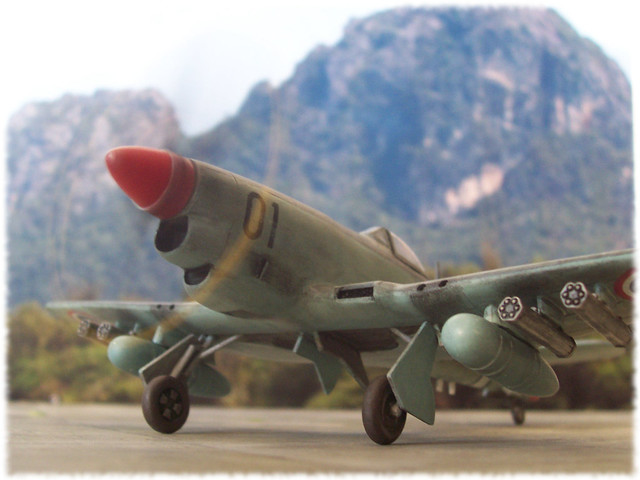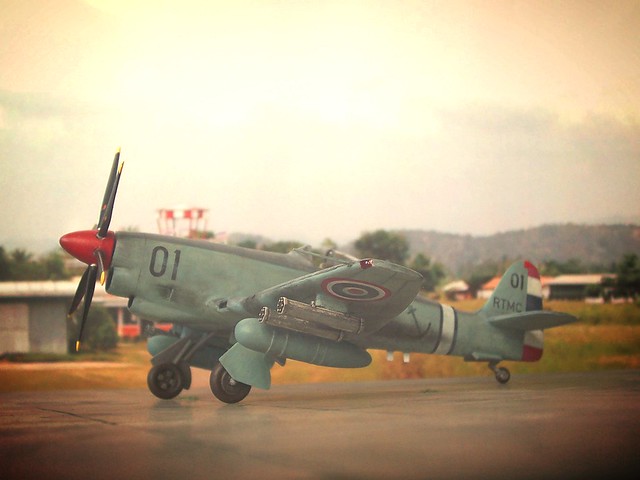
1:72 Hawker-PAC 'Turbo Fury'; aircraft '01' of the Royal Thai Marine Corps (นาวิกโยธินแห่งราชอาณาจักรไทย); Chanthaburi region, 1969 (Whif/PM Model kit conversion) by
dizzyfugu, on Flickr

1:72 Hawker-PAC 'Turbo Fury'; aircraft '01' of the Royal Thai Marine Corps (นาวิกโยธินแห่งราชอาณาจักรไทย); Chanthaburi region, 1969 (Whif/PM Model kit conversion) by
dizzyfugu, on Flickr
The Sea Fury was a British fighter aircraft designed and manufactured by Hawker. It was the last propeller-driven fighter to serve with the Royal Navy, and also one of the fastest production single piston-engined aircraft ever built. Developed during the Second World War, the Sea Fury entered service two years after the war ended. The Sea Fury proved to be a popular aircraft with a number of overseas militaries, and it was successfully used during the Korean War in the early 1950s where it could keep up with 1st generatiom jet fighters like the MiG-15.
The Sea Fury's development was formally initiated in 1943 in response to a wartime requirement of the RAF, thus the aircraft was initially named Fury. As the Second World War drew to a close, the RAF cancelled their order for the aircraft. However, the Royal Navy saw the type as a suitable carrier aircraft to replace a range of increasingly obsolete or poorly suited aircraft being operated by the Fleet Air Arm. Development of the Sea Fury proceeded, and the type began entering operational service in 1947.
 1:72 Hawker-PAC 'Turbo Fury'; aircraft '01' of the Royal Thai Marine Corps (นาวิกโยธินแห่งราชอาณาจักรไทย); Chanthaburi region, 1969 (Whif/PM Model kit conversion) by dizzyfugu, on Flickr
1:72 Hawker-PAC 'Turbo Fury'; aircraft '01' of the Royal Thai Marine Corps (นาวิกโยธินแห่งราชอาณาจักรไทย); Chanthaburi region, 1969 (Whif/PM Model kit conversion) by dizzyfugu, on Flickr
 1:72 Hawker-PAC 'Turbo Fury'; aircraft '01' of the Royal Thai Marine Corps (นาวิกโยธินแห่งราชอาณาจักรไทย); Chanthaburi region, 1969 (Whif/PM Model kit conversion) by dizzyfugu, on Flickr
1:72 Hawker-PAC 'Turbo Fury'; aircraft '01' of the Royal Thai Marine Corps (นาวิกโยธินแห่งราชอาณาจักรไทย); Chanthaburi region, 1969 (Whif/PM Model kit conversion) by dizzyfugu, on Flickr
 1:72 Hawker-PAC 'Turbo Fury'; aircraft '01' of the Royal Thai Marine Corps (นาวิกโยธินแห่งราชอาณาจักรไทย); Chanthaburi region, 1969 (Whif/PM Model kit conversion) by dizzyfugu, on Flickr
1:72 Hawker-PAC 'Turbo Fury'; aircraft '01' of the Royal Thai Marine Corps (นาวิกโยธินแห่งราชอาณาจักรไทย); Chanthaburi region, 1969 (Whif/PM Model kit conversion) by dizzyfugu, on Flickr
The Sea Fury had many design similarities to Hawker's preceding Tempest fighter, but the Sea Fury was a considerably lighter aircraft. Both the Sea Fury's wings and fuselage originated from the Tempest but were significantly modified and redesigned. Production Sea Furies were fitted with the powerful Bristol Centaurus engine, and armed with four wing-mounted Hispano V 20mm cannons. While originally developed as a pure aerial fighter aircraft, the definitive Sea Fury FB 11 was a fighter-bomber, the design having been found suitable for this mission as well.
The Sea Fury attracted international orders as both a carrier and land-based aircraft; it was operated by countries including Australia, Burma, Canada, Cuba, Egypt, West Germany, Iraq, and Pakistan. The Sea Fury was retired by the majority of its military operators in the late 1950s in favour of jet-propelled aircraft. One of the largest export customers for the type, Pakistan, went a different way.
Originally, an initial order for 50 Sea Fury FB 60 aircraft for the Pakistan Air Force (PAF) was placed in 1949. A total of 87 new-build Sea Furies were purchased and delivered between 1950 and 1952, but some ex-FAA and Iraqi Sea Furies were also subsequently purchased.
 1:72 Hawker-PAC 'Turbo Fury'; aircraft '01' of the Royal Thai Marine Corps (นาวิกโยธินแห่งราชอาณาจักรไทย); Chanthaburi region, 1969 (Whif/PM Model kit conversion) by dizzyfugu, on Flickr
1:72 Hawker-PAC 'Turbo Fury'; aircraft '01' of the Royal Thai Marine Corps (นาวิกโยธินแห่งราชอาณาจักรไทย); Chanthaburi region, 1969 (Whif/PM Model kit conversion) by dizzyfugu, on Flickr
The Sea Fury began to be replaced by the jet-powered North American F-86 Sabre in 1955, but it became quickly clear that the Sabre was primarily a fighter, not a ground attack aircraft. It also lacked adequate performance in 'hot and high' operation theatres, and the PAF's B-57 bombers were too big for certain CAS tasks, and their number highly limited.
Hence the decision was taken to modernize a part of the PAF Sea Fury fleet for the ground attack role. This was to be achieved with a better engine that would deliver more power, a better overall performance as well as an extended range for prolonged loiter times close to the potential battlefield.
Engine choice fell on the Allison T56 turboshaft engine, which had originally been developed for the C-130 Hercules transporter (later also installed in the P-3 and E-2) - the type had just been bought by the PAF, so that low maintenance cost due to parts and infrastructure commonality was expected. Pakistan Aeronautical Complex (commonly abbreviated 'PAC') was tasked to develop a suitable update, and this lead to the integration of a turboprop engine into the Sea Fury airframe.
For the relatively small Sea Fury airframe the T56 was downrated to 3.000 hp, to which approximately 750 lbs of thrust from its exhaust could be added. The latter was bifurcated and ran along the fuselage flanks, ending in fairings at the wings' trailing edge. In order to cope with the additional power, the original five-bladed propeller had to be replaced by a six-bladed, indigenously developed propeller. Together with the more pointed spinner and the raised propeller position, the Sea Fury's profile changed dramatically, even though the good field of view for the pilot was retained. Officially, the modified machines were just called 'Sea Fury FB.61', inofficially they were called 'Turbo Furies' or 'وایلار' (Urdu: Wailer), for their characteristic, penetrating engine and propeller sound.
 1:72 Hawker-PAC 'Turbo Fury'; aircraft '01' of the Royal Thai Marine Corps (นาวิกโยธินแห่งราชอาณาจักรไทย); Chanthaburi region, 1969 (Whif/PM Model kit conversion) by dizzyfugu, on Flickr
1:72 Hawker-PAC 'Turbo Fury'; aircraft '01' of the Royal Thai Marine Corps (นาวิกโยธินแห่งราชอาณาจักรไทย); Chanthaburi region, 1969 (Whif/PM Model kit conversion) by dizzyfugu, on Flickr
Internally, structural reinforcements had to be made and new wing spars were introduced. These allowed higher g forces for low level maneuvers and also carried additional ordnance hardpoints under the outer wings - these enabled the aircraft to carry HVARs of American origin and/or several small caliber bombs instead of only a single pair of up to 1.000 lb (454 kg) caliber.
The last piston engine Sea Furies in Pakistani service were ultimately retired in 1960, while the Turbo Fury fleet was used throughout the 1965 India-Pakistan War. After the end of hostilities, the 'Turbo Furies' were quickly phased out since it had become clear that they had become too vulnerable in battlefield conditions.
Some of these machines was sold to Thailand, though. Due to its close proximity with Thailand, Vietnam's conflict was closely monitored by Bangkok. Thai involvement in Vietnam did not become official until the total involvement of the United States in 1963, and Thailand allowed the United States Air Force in Thailand to use air bases and naval bases for U.S. forces. Furthermore, constant border disputes with Cambodia urged the government to enlarge the military arsenal.
 1:72 Hawker-PAC 'Turbo Fury'; aircraft '01' of the Royal Thai Marine Corps (นาวิกโยธินแห่งราชอาณาจักรไทย); Chanthaburi region, 1969 (Whif/PM Model kit conversion) by dizzyfugu, on Flickr
1:72 Hawker-PAC 'Turbo Fury'; aircraft '01' of the Royal Thai Marine Corps (นาวิกโยธินแห่งราชอาณาจักรไทย); Chanthaburi region, 1969 (Whif/PM Model kit conversion) by dizzyfugu, on Flickr
As a consequence, the Royal Thai Marine Corps received 13 Turbo Furys for the CAS role in 1966. Actually, these were the first aircraft for the naval air arm since 1951, because after a coup attempt by the Navy to overthrow the prime minister Phibun Songkhram the Government had decided to remove all planes from the Navy and give it to the Royal Thai Air Force.
The Thai Turbo Furys saw frequent use: The Chanthaburi and Trat borders with Cambodia gave the Marine Corps Department its first assignment, safeguarding the coastline and southeastern border. Since 1970 the Marine Corps' Chanthaburi-Trat Task Force had been officially assigned the defense of this area.
 1:72 Hawker-PAC 'Turbo Fury'; aircraft '01' of the Royal Thai Marine Corps (นาวิกโยธินแห่งราชอาณาจักรไทย); Chanthaburi region, 1969 (Whif/PM Model kit conversion) by dizzyfugu, on Flickr
1:72 Hawker-PAC 'Turbo Fury'; aircraft '01' of the Royal Thai Marine Corps (นาวิกโยธินแห่งราชอาณาจักรไทย); Chanthaburi region, 1969 (Whif/PM Model kit conversion) by dizzyfugu, on Flickr
 1:72 Hawker-PAC 'Turbo Fury'; aircraft '01' of the Royal Thai Marine Corps (นาวิกโยธินแห่งราชอาณาจักรไทย); Chanthaburi region, 1969 (Whif/PM Model kit conversion) by dizzyfugu, on Flickr
1:72 Hawker-PAC 'Turbo Fury'; aircraft '01' of the Royal Thai Marine Corps (นาวิกโยธินแห่งราชอาณาจักรไทย); Chanthaburi region, 1969 (Whif/PM Model kit conversion) by dizzyfugu, on Flickr
During 1972 and 1973, Thai Marines were involved in the "Sam-Chai" anti-communist operations in Phetchabun Province and the "Pha-Phum" anti-communist operations in Chiang Rai Province. In 1973 and 1974, they took part in anti-communist operations in the southern provinces of Pattani, Yala and Narathiwat.
Since 1975, Thai Marines have been assigned to Narathiwat as Marine Corps special forces, and this. after ten years of frequent and successful use, was the end of the Thai Tubro Furies - the type was retired in late 1975. Two specimen were sold into the USA and the remaining airframes (a total of 5 had been lost, two through accidents and three had been shot down by AA fire) were scrapped.General characteristics Crew: One
Length: 36 ft 2 in (11.05 m)
Wingspan: 38 ft 43⁄4 in (11.69 m)
Height: 15 ft 101⁄2 in (4.84 m)
Wing area: 280 ft2 (26.01 m2)
Empty weight: 10.500 lb (4.767 kg)
Loaded weight: 14,100 lb (6.400 kg)
Max. takeoff weight: 15,650 lb (7.105 kg)
Powerplant: 1× Allison T56 turboshaft engine rated at 2.206 kW (3.000 hp) plus 750 lbs of residual thrust
Performance: Maximum speed: 490 mph (427 knots, 790 km/h) at 18,000 ft (5,500 m)
Range: 700 mi (609 nmi, 1,126 km) with internal fuel;
1,040 mi (904 nmi, 1,674 km) with two drop tanks
Service ceiling: 35,800 ft (10,910 m)
Rate of climb: 4,320 ft/min (21.9 m/s)
Armament: 4× 20 mm (.79 in) Hispano Mk V cannons in the wings
Eight underwing hardpoints for an external load of 4.000 lb (1.814 kg),
including bombs, unguided rockets, napalm tanks or drop tanks
Teil 2 der Modell-Trilogie - entstanden aus einem 4er-Set mit Resin-Ersatz-Triebwerken aus einem C-130 Umrüstsatz (von RedRoo aus Australien), die zufällig fast genau an den Rumpf einer Hawker Sea Fury (PM Models) passen. Der Rest ist Fiktion, bzw. das konsequente Weiterspinnen der Idee über die Jahre und das Verbraten von Triebwerken und Bausätzen.

Und es ist noch nicht das Ende...


1:72 Hawker-PAC 'Turbo Fury'; aircraft '01' of the Royal Thai Marine Corps (นาวิกโยธินแห่งราชอาณาจักรไทย); Chanthaburi region, 1969 (Whif/PM Model kit conversion) by
dizzyfugu, on Flickr

1:72 Hawker-PAC 'Turbo Fury'; aircraft '01' of the Royal Thai Marine Corps (นาวิกโยธินแห่งราชอาณาจักรไทย); Chanthaburi region, 1969 (Whif/PM Model kit conversion) by
dizzyfugu, on Flickr

1:72 Hawker-PAC 'Turbo Fury'; aircraft '01' of the Royal Thai Marine Corps (นาวิกโยธินแห่งราชอาณาจักรไทย); Chanthaburi region, 1969 (Whif/PM Model kit conversion) by
dizzyfugu, on Flickr

1:72 Hawker-PAC 'Turbo Fury'; aircraft '01' of the Royal Thai Marine Corps (นาวิกโยธินแห่งราชอาณาจักรไทย); Chanthaburi region, 1969 (Whif/PM Model kit conversion) by
dizzyfugu, on Flickr

1:72 Hawker-PAC 'Turbo Fury'; aircraft '01' of the Royal Thai Marine Corps (นาวิกโยธินแห่งราชอาณาจักรไทย); Chanthaburi region, 1969 (Whif/PM Model kit conversion) by
dizzyfugu, on Flickr

1:72 Hawker-PAC 'Turbo Fury'; aircraft '01' of the Royal Thai Marine Corps (นาวิกโยธินแห่งราชอาณาจักรไทย); Chanthaburi region, 1969 (Whif/PM Model kit conversion) by
dizzyfugu, on Flickr